In today’s digital world, virtual playdates have become an essential way for children to maintain social connections when in-person gatherings aren’t possible. Establishing a consistent virtual playdate schedule can provide structure and social interaction that kids crave, while helping parents manage their own work responsibilities. Creating an effective virtual playdate schedule requires balancing your child’s social needs with appropriate screen time limits and finding activities that engage children meaningfully across digital platforms.
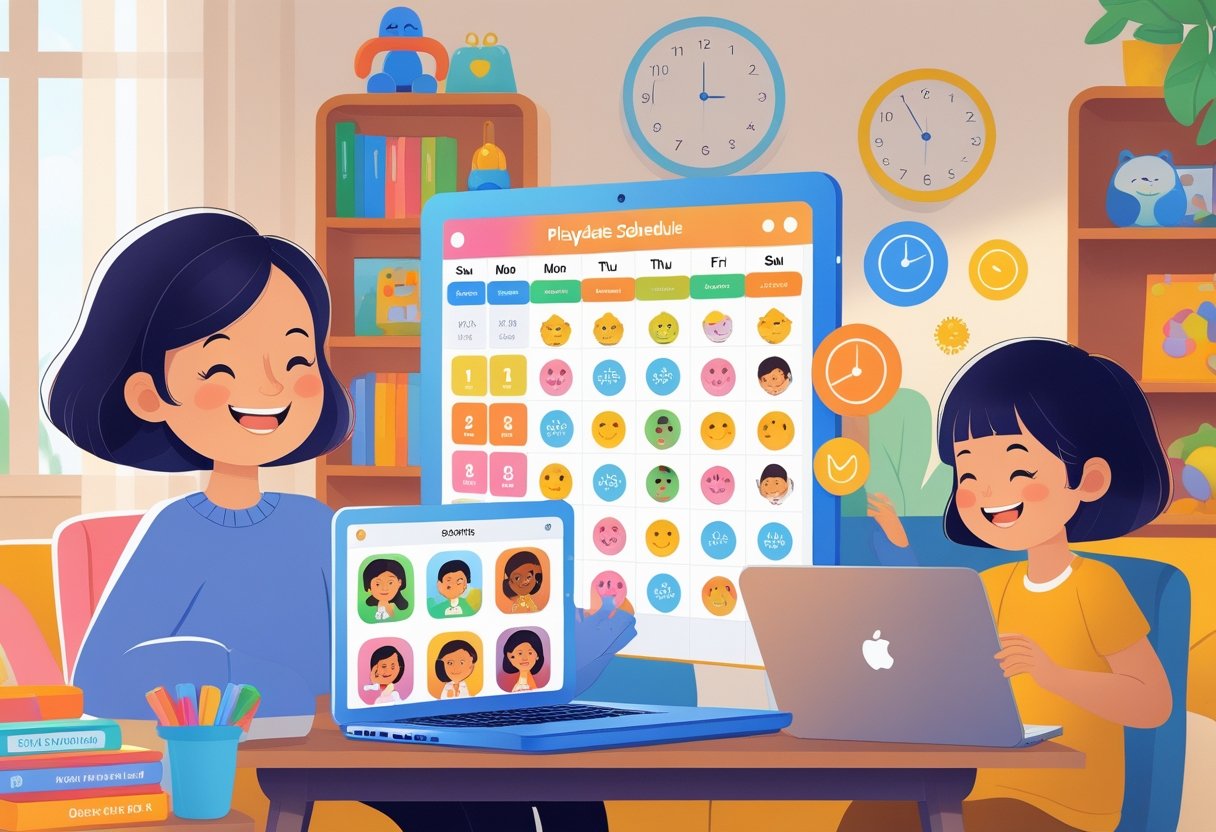
As a parent who has navigated this terrain extensively, I’ve discovered that successful virtual playdates don’t just happen—they require thoughtful planning and coordination. The right schedule considers your child’s energy levels throughout the day, other families’ availability, and incorporates varied activities that promote genuine interaction rather than passive screen time.
Key Takeaways
- Regular virtual playdates provide crucial social development opportunities while maintaining a structured routine for children.
- Coordinating with other parents ahead of time ensures both technical issues and activity plans are addressed before children connect.
- Incorporating a variety of engaging activities and scheduled breaks prevents digital fatigue while maximizing the quality of social interaction.
Why Virtual Playdates Matter
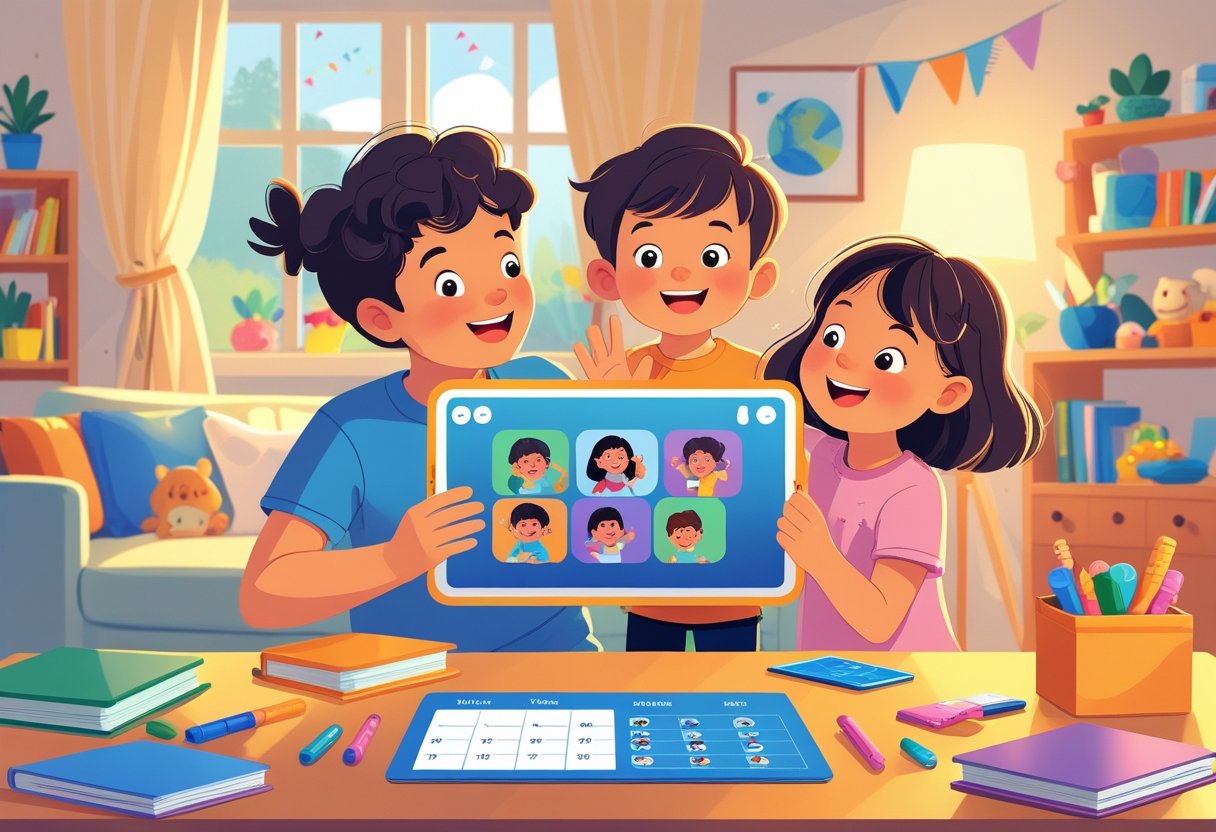
Virtual playdates provide crucial social connections for children while helping them develop tech skills and giving parents flexible options for maintaining their kids’ friendships during times when in-person meetings aren’t possible.
Benefits for Children’s Social Skills
Children develop essential social skills through regular peer interaction, whether virtual or in-person. Virtual playdates help children stay connected to their friends and continue building relationships despite physical separation. These online meetups encourage turn-taking, listening, and responding appropriately during conversation.
I’ve observed that virtual playdates actually help some shy children feel more comfortable socializing from their familiar home environment. They can practice social skills in a less overwhelming setting before transferring these abilities to in-person situations.
Children also become more tech-savvy through these interactions, learning valuable digital communication skills that will serve them throughout their lives. They develop patience, problem-solving, and adaptability when navigating the occasional technical challenges.
Virtual playdates can specifically encourage imaginative play as children find creative ways to engage across screens. Kids often invent games, share stories, or participate in parallel activities like drawing or building with blocks.
Meeting Emotional Needs Remotely
Children need consistent social connection for emotional well-being, and virtual playdates fulfill this crucial requirement. I’ve found that these online interactions provide comfort and stability during uncertain times when regular routines are disrupted.
Kids learn that friendships can thrive despite physical distance, an important emotional resilience lesson. They experience joy and excitement anticipating these scheduled connections, giving them something positive to look forward to.
Virtual meetups help combat feelings of isolation and loneliness that can develop when children are separated from peers. Regular screen-based interaction provides emotional reassurance that their friendships remain intact despite changing circumstances.
Tools like prepared conversation starters can help children express their feelings and concerns with friends, creating deeper emotional connections. I recommend having a game plan for successful virtual playdates to ensure meaningful emotional engagement.
Supporting Parents with Remote Interaction
Virtual playdates offer parents a manageable way to maintain their children’s social lives without the logistical challenges of in-person meetups. I recommend using platforms like Skype, Google Hangouts, or Zoom to connect children with friends on a regular schedule.
These online interactions give parents flexibility while working from home or managing busy households. Parents can be nearby to provide tech support while still allowing children independent social time with friends.
Virtual playdates require minimal preparation compared to hosting physical gatherings. No cleaning before guests arrive, no preparing snacks, and no transportation logistics make these meetups easier to fit into packed family schedules.
Parents can use these guidelines for successful virtual playdates to ensure positive experiences. I suggest creating a simple weekly calendar with scheduled virtual playdates to help children know when they’ll connect with specific friends.
Planning a Virtual Playdate Schedule
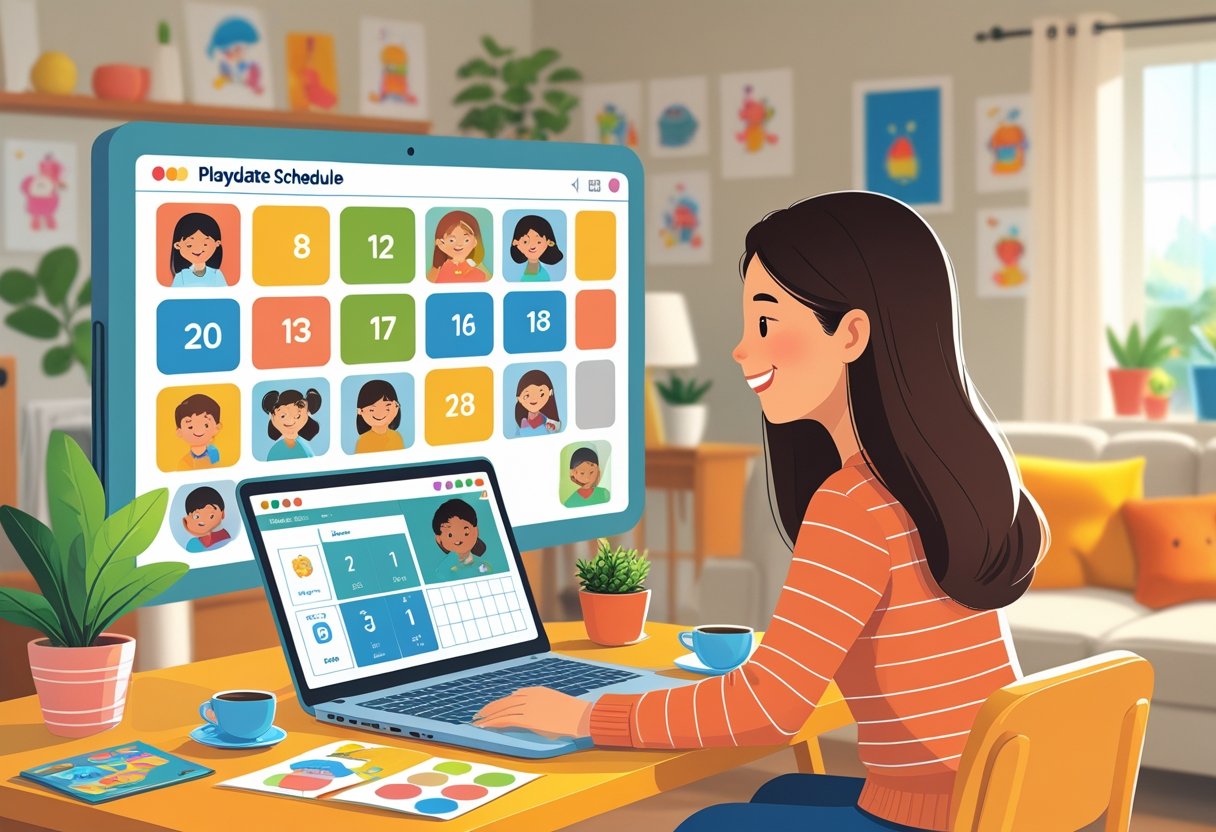
Creating a structured schedule for virtual playdates helps maintain social connections for children while ensuring these digital interactions fit seamlessly into family life. A well-planned approach considers timing, family needs, and age-appropriate activities that keep children engaged.
Choosing the Best Days and Times
I’ve found that weekday afternoons (between 4-6 PM) or weekend mornings work best for most families with school-aged children. This timing avoids academic hours while catching kids before evening routines begin.
Consider your child’s energy patterns when scheduling. Some children are more focused and social in the mornings, while others shine in afternoon interactions.
Keep meetings short – planning for 30-minute activities works well as some children burn out quickly while others could stay connected longer. For younger children (3-5 years), 15-20 minutes is often sufficient.
Time zones matter for distant friends! I recommend using a shared calendar tool that automatically adjusts for different time zones to avoid confusion.
Aligning With Family Routines
I always advise embedding virtual playdates into existing family schedules rather than disrupting established routines. This creates consistency and reduces resistance.
Creating a game plan each morning helps children understand when these social interactions fit into their day. Visual schedules work particularly well for younger children.
Consider these practical alignment strategies:
- Schedule after homework but before dinner
- Plan weekend playdates during typical in-person playdate hours
- Block 10 minutes before and after for technical setup and proper goodbyes
- Avoid bedtime hours when children may be tired or cranky
Family commitments should take priority – I recommend creating a bi-weekly or monthly schedule to ensure consistency without overcommitment.
Incorporating Age-Appropriate Activities
Having a game plan is crucial for successful virtual playdates. I recommend preparing activities that match children’s developmental stages and interests.
For preschoolers (3-5 years):
- Show-and-tell sessions (2-3 minutes per child)
- Simple scavenger hunts for common household items
- Parallel play with similar toys (blocks, dolls)
For elementary-aged children (6-10 years):
- Kahoot quizzes or art sessions
- Collaborative storytelling games
- Virtual board games modified for screen sharing
For tweens (11-13 years):
- Online multiplayer games with voice chat
- Craft projects they can work on simultaneously
- Book club discussions or movie watching parties
I suggest incorporating social skills practice into these activities, like taking turns, asking questions, and active listening. These skills don’t develop automatically in virtual settings.
Selecting Safe Digital Platforms

Choosing the right technology for your child’s virtual playdates involves evaluating security features, privacy protections, and obtaining proper consent from other parents. These factors work together to create a safe online environment where kids can socialize without unnecessary risks.
Evaluating Child-Friendly Video Chat Tools
When selecting platforms for virtual playdates, I recommend starting with established video calling services like Zoom, FaceTime, WhatsApp, or Skype. Each offers distinct advantages for different age groups. Caribu and Marco Polo provide excellent alternatives with child-friendly interfaces and built-in activities.
Look for platforms with these key features:
- Simple interfaces that children can navigate independently
- Screen sharing capabilities for collaborative games
- Parental controls to monitor communication
- Limited chat functions to prevent unwanted messages
I’ve found that platforms designed specifically for children often include fun filters and interactive elements that keep younger kids engaged. For older children, services with gaming integration like Discord may work better, but require closer supervision.
Ensuring Online Privacy
Privacy should be a top priority when creating virtual playdate environments. I always set time limits to prevent excessive screen time and reduce privacy risks. This also helps maintain a healthy balance between virtual and physical activities.
Consider these privacy protection steps:
- Use password-protected meetings
- Enable waiting rooms to control who joins
- Disable recording features when possible
- Review privacy policies before installing apps
I make it a habit to position screens appropriately during playdates to limit what’s visible in your home. Place the device against a plain wall rather than showing personal spaces, and check what appears in the background before connecting.
Obtaining Parental Consent
Before scheduling any virtual playdate, I always obtain clear permission from the other child’s parents. This creates trust between families and ensures everyone understands the arrangement.
When requesting consent, I include:
- Which platform will be used
- Expected duration of the playdate
- Whether adults will be supervising
- Any activities planned that require preparation
I find that creating a simple digital consent form works well for regular playdate groups. For closer friends, a text message confirmation is usually sufficient. Virtual playdates help children maintain social connections even during periods of isolation, making proper consent procedures worth the effort.
Remember that some families may have specific rules about technology use, so be respectful of different comfort levels with digital interaction.
Coordinating With Other Parents
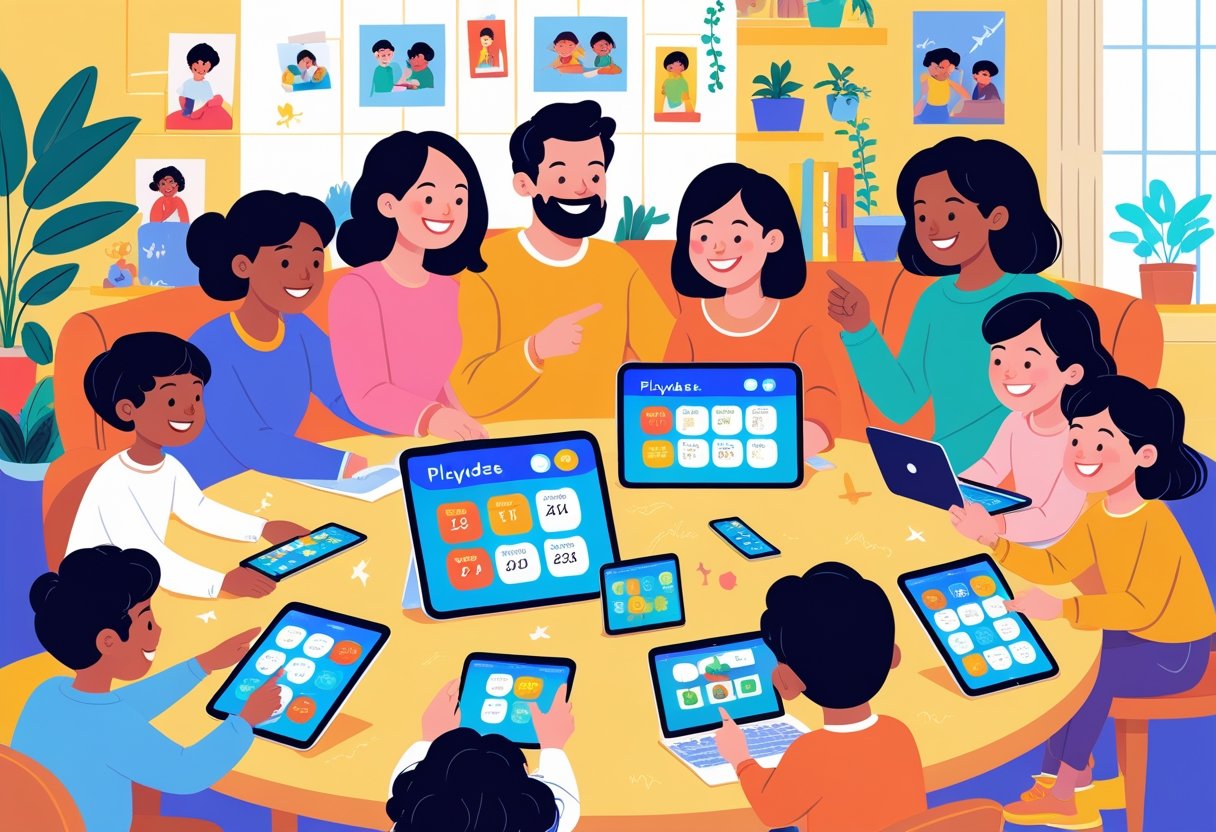
Successful virtual playdates require thoughtful coordination with other parents to ensure everyone has a positive experience. Effective communication and mutual understanding create the foundation for enjoyable online interactions between children.
Establishing Clear Communication Channels
I’ve found that creating a dedicated communication channel specifically for playdate coordination makes everything run more smoothly. A group chat on WhatsApp or a shared Google Calendar can help everyone stay informed about upcoming virtual gatherings.
Parents often appreciate having contact information organized in one place. I recommend creating a simple spreadsheet with names, preferred contact methods, and time zone information if connecting across different regions.
Round robin approaches work well for managing virtual interactions, where each child gets a spotlight moment. I always make sure all parents understand how to use video platform features like muting, spotlighting, and screen sharing before the first playdate.
Regular check-ins with other parents help identify what’s working and what needs adjustment in your communication process.
Setting Shared Expectations
I always discuss behavior expectations with other parents before virtual playdates begin. This includes agreeing on screen time limits, adult supervision levels, and appropriate activities.
Being clear about the playdate structure helps everyone prepare properly. I share details like:
- Duration of the playdate (30-45 minutes often works best)
- Activities planned (games, show-and-tell, etc.)
- Materials needed in advance
- Parent involvement expectations
When everyone understands what to expect, children can focus on having fun rather than navigating confusion. I’m always careful to consider each child’s unique needs and abilities when setting these expectations.
Addressing Scheduling Conflicts
Finding schedules that align can be challenging, especially with families juggling multiple commitments. I use scheduling tools like Doodle or When2Meet to find times that work for everyone without endless back-and-forth messages.
I always build in buffer time between activities and plan virtual playdates when children are typically at their best—not during meal times or too close to bedtime. This minimizes cancellations and behavioral issues.
When conflicts do arise, I maintain flexibility and create a simple system for rescheduling. Having backup dates already identified helps tremendously when last-minute changes occur.
I recommend creating a shared calendar with recurring playdate slots that parents can opt into or out of each week, providing structure while maintaining flexibility.
Engaging Virtual Playdate Activities
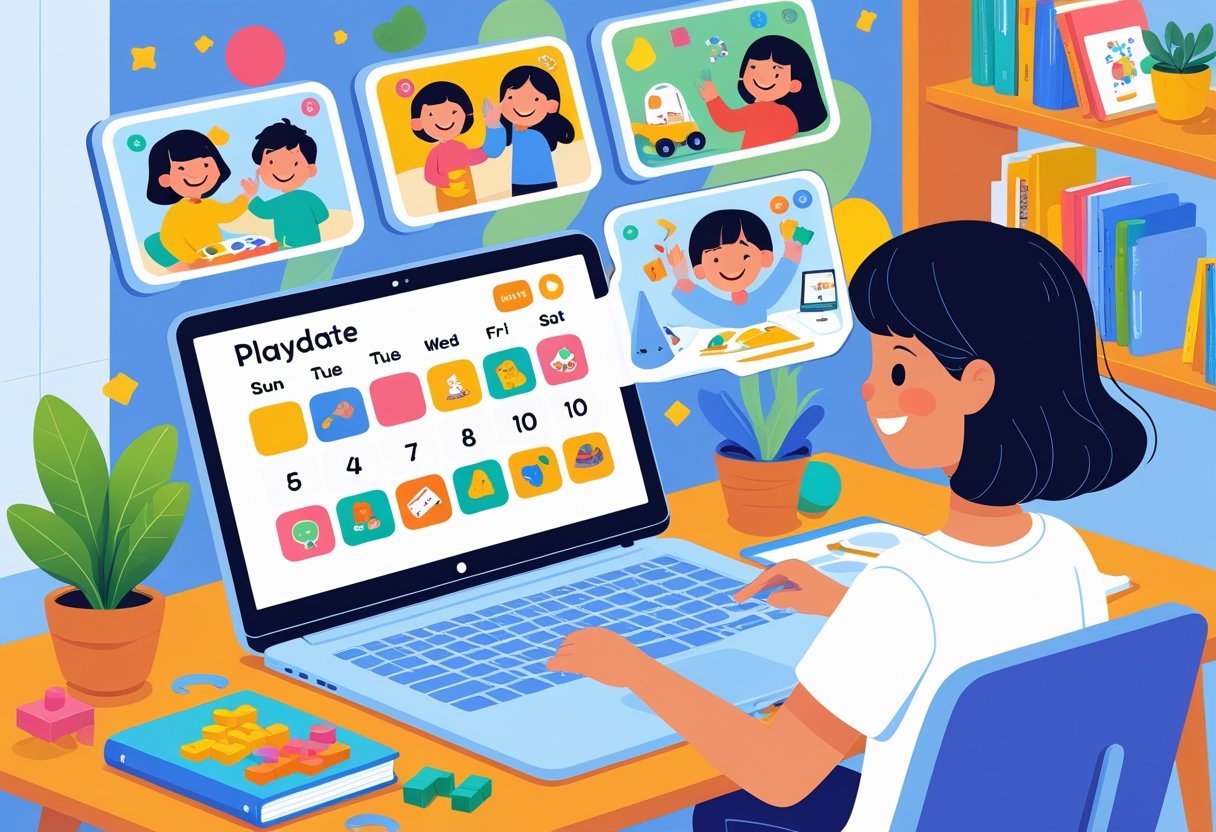
Virtual playdates offer numerous opportunities for children to connect and have fun despite physical distance. When carefully planned with interactive elements, these digital get-togethers can be just as engaging as in-person meetings.
Creative Games and Crafts
Kids can participate in virtual scavenger hunts where they search for common household items. I recommend preparing a list beforehand and sharing your screen to reveal items one by one. This creates excitement as children race to find objects.
Art sessions work wonderfully in a virtual environment. Have materials ready in advance—simple supplies like paper, crayons, and scissors are sufficient. Children can follow along with directed drawing activities or create their own masterpieces while chatting.
Collaborative crafting provides a shared experience. Choose projects using basic materials most families have on hand. Guide the children step-by-step while allowing conversation to flow naturally between instructions.
Virtual dance parties need minimal preparation but deliver maximum fun. Create a shared playlist or take turns being the DJ. Kids love showing off their moves and learning new ones from friends.
Storytelling and Reading Sessions
Taking turns reading favorite books creates an intimate sharing experience. Children can select short stories or take turns reading pages from the same digital book if resources are shared.
I find that story creation games spark tremendous creativity. Start a tale with one sentence, then have each child add the next part. The resulting collaborative stories often take hilarious and unexpected turns.
Character role-play encourages imagination development. Children can dress up as favorite characters and act out scenes or create new adventures together.
Puppet shows require minimal props but provide endless entertainment. Children can make simple sock or paper bag puppets beforehand, then use them to perform impromptu shows for their friends.
Collaborative Online Experiences
Board games have successfully transitioned to digital formats. Many classic games have online versions where friends can play together. Some platforms even offer virtual game rooms specifically designed for children.
Shared viewing experiences like watching short educational videos together can spark interesting discussions. Platforms like Zoom and Google Hangouts allow screen sharing for this purpose.
Virtual band practice or sing-alongs work surprisingly well. Children can take turns performing favorite songs or play simple instruments together. The slight delay doesn’t diminish the joy of creating music.
Show-and-tell sessions remain popular in virtual settings. I suggest establishing a theme for each session—favorite toys, books, or collections—to provide structure and prevent overlapping presentations.
Educational Play Ideas
Conducting interviews teaches children communication skills. They can prepare questions for each other about hobbies, favorites, or experiences, fostering deeper friendships while improving their inquiry abilities.
Science experiments using common household items make for exciting shared discoveries. Simple experiments like baking soda volcanoes or color mixing activities work well when done simultaneously on screen.
Virtual field trips to museums, zoos, or historical sites that offer online tours create shared learning experiences. Children can explore these digital spaces together while discussing what they’re seeing.
Math and word games develop academic skills while maintaining a playful atmosphere. Simple games like counting challenges, word association, or even competitive flashcard races keep minds active while socializing.
Managing Screen Time and Breaks
Finding the right balance between engaging virtual playdates and necessary breaks is essential for your child’s wellbeing. Effective screen management prevents digital fatigue while maximizing the social benefits of online interaction.
Setting Healthy Time Limits
I recommend establishing clear screen time boundaries before virtual playdates begin. For younger children (ages 3-5), limit sessions to 20-30 minutes, while older children (ages 6-12) can handle 30-45 minute sessions. Consider using a screen time schedule that provides structure without being overly rigid.
Use visual timers that children can easily understand, such as sand timers or digital countdown apps. These provide concrete representations of time remaining rather than abstract concepts.
Consistency is key – maintain similar timeframes across weekdays and adjust slightly for weekends if needed. I’ve found that discussing these limits with your child beforehand helps prevent meltdowns when it’s time to disconnect.
Include 5-minute warnings before the playdate ends to help children transition more smoothly. This gives them time to wrap up activities and say proper goodbyes.
Balancing Virtual and Offline Play
Turn screen time into quality time by alternating between virtual sessions and tangible activities. I suggest scheduling virtual playdates with built-in offline breaks – for example, 30 minutes online followed by 30 minutes of physical play.
Create “parallel play” opportunities where friends can disconnect but continue similar activities independently. Both children might build with blocks separately, then reconnect to show their creations.
Designate screen-free zones in your home, particularly in bedrooms and dining areas. This helps children understand that certain spaces are meant for non-digital connections and activities.
I’ve noticed that children who have a balance of both virtual and in-person interactions develop stronger social skills overall. Virtual playdates complement rather than replace traditional play experiences.
Incorporating Physical Movement
Physical activity should be integrated before, during, and after virtual playdates. Start with a quick 5-minute stretching or jumping session before sitting down at the screen to help release excess energy.
During longer virtual sessions, incorporate movement-based games like:
- Simon Says
- Dance breaks
- Scavenger hunts around the house
- Follow-the-leader exercises
Encouraging physical activity helps counteract the sedentary nature of screen time. I suggest setting timers for quick movement breaks every 15-20 minutes during extended playdates.
After the virtual playdate ends, guide your child toward physical play options. Having a ready list of activities like backyard games, bike riding, or indoor obstacle courses makes the transition easier and more appealing.
Troubleshooting Challenges
Virtual playdates can encounter hiccups, but with the right approach, most issues can be quickly resolved so children can continue enjoying their social time.
Dealing with Technical Difficulties
When technical problems arise during virtual playdates, I recommend staying calm and having backup options ready. Connection issues are common but usually temporary. Try refreshing the browser or restarting the app before giving up.
Keep a list of alternative platforms handy. If Zoom isn’t working, switch to Google Hangouts or Skype as a quick alternative.
Test your equipment before each session. A quick 5-minute check of camera, microphone, and internet connection can prevent most technical disruptions.
For persistent issues, consider:
- Moving closer to your WiFi router
- Closing other bandwidth-heavy applications
- Using wired connections instead of wireless when possible
- Scheduling playdates during off-peak internet usage times
Encouraging Shy or Hesitant Children
Shy children may need extra support to feel comfortable on virtual playdates. I find that having conversation starters prepared helps tremendously, especially for children who struggle with initiating interaction.
Start with shorter sessions of 15-20 minutes to prevent overwhelm. Gradually increase duration as your child gains confidence.
Choose familiar peers for initial virtual playdates rather than new acquaintances. The comfort of an established relationship can reduce anxiety.
Prepare structured activities in advance. Games like scavenger hunts or show-and-tell give hesitant children clear roles and reduce social pressure.
Provide positive reinforcement after sessions, highlighting specific moments when your child engaged well. This builds confidence for future interactions.
Handling Disagreements or Misunderstandings
Virtual environments can amplify misunderstandings since children miss physical cues. I recommend discussing virtual playdate etiquette beforehand, especially with preschoolers and elementary-aged children.
Teach children to use clear language about their feelings: “I feel upset because…” instead of just becoming frustrated. This helps bridge the communication gap created by screens.
For younger children, stay nearby without hovering. This allows you to step in if disagreements escalate while still giving them independence.
When conflicts arise, use them as teaching moments. Pause the activity briefly to help children identify the social struggle and practice resolution skills.
Create simple rules like taking turns speaking or using a visual “talking stick” that children can hold up when they want to talk.
Evaluating Success and Making Improvements
Virtual playdates require ongoing assessment to ensure they remain beneficial for children’s social development. Regular check-ins help identify what’s working well and what needs adjustment to maintain engagement and foster meaningful connections.
Gathering Feedback from Kids
After each virtual playdate, I make it a point to have a casual chat with my children about their experience. I ask specific questions about their favorite activities, moments when they felt bored, and friends they enjoyed interacting with most.
I’ve found that using simple rating systems works well. For younger kids, I use a thumbs up/down approach, while older children can rate activities on a scale of 1-5 stars.
Some helpful questions I ask include:
- What was your favorite part of today’s playdate?
- Did you feel like you had enough time to talk with your friends?
- Was there anything that made you feel frustrated or confused?
Recording this feedback in a simple notebook or digital document helps me track patterns and see which activities consistently engage my children.
Adjusting Schedules and Activities
Based on collected feedback, I regularly fine-tune our virtual playdate approach. If my children mention feeling rushed, I extend future sessions by 10-15 minutes or reduce the number of planned activities.
I’ve learned to be flexible with timing. Sometimes creating a game plan each morning works better than strict scheduling, allowing for spontaneity while maintaining structure.
Activity adjustments might include:
- Replacing competitive games with collaborative projects if conflicts arise
- Adding more movement breaks when attention spans wane
- Incorporating new interactive activities based on emerging interests
I remain mindful of technical issues too. If video quality consistently causes problems, I might switch platforms or reduce the number of participants per session.
Celebrating Ongoing Friendships
I make a conscious effort to highlight the relationships that develop through virtual playdates. Taking screenshots (with permission) of smiling faces during group activities creates wonderful mementos.
I encourage my children to create friendship projects between sessions—drawings, letters, or collaborative digital projects they can share at the next meetup. This maintains connection between scheduled times.
Special virtual events like birthday celebrations or holiday-themed playdates provide milestone moments that strengthen bonds. I incorporate creative ideas like virtual scavenger hunts or synchronized movie viewing parties to keep the experience fresh.
For long-distance friendships especially, I help my children recognize how virtual connections help build social skills and maintain important relationships despite physical distance.
Frequently Asked Questions
Parents often struggle with specific aspects of virtual playdates, from activity planning to technical setup. Understanding these common concerns can help create more successful online social experiences for children.
What activities can children engage in during a virtual playdate?
Children can participate in show-and-tell sessions where they share favorite toys or recent crafts with friends. This simple activity encourages communication and sharing.
Online board games like Checkers, Chess, or multiplayer apps designed for kids provide structured interaction that mimics in-person play experiences.
Drawing or coloring together while on video can be engaging. I recommend having supplies ready beforehand and possibly using a shared virtual whiteboard for collaborative creation.
Scavenger hunts work surprisingly well virtually. I create lists of everyday household items for kids to find and show to their friends, turning the home environment into part of the play experience.
How can parents ensure the safety and privacy of children during online playdates?
I always supervise younger children during virtual playdates, especially those under 8 years old. Periodic check-ins work better for older children to balance independence with safety.
Use password-protected meeting rooms and never share meeting links publicly. This prevents unauthorized access to your child’s virtual playdate.
Familiarize yourself with privacy settings on chosen platforms. Features like waiting rooms and participant approval give you control over who joins the virtual environment.
Establish clear rules about screen sharing and chat functions based on your child’s age. These boundaries help maintain appropriate interactions during online play sessions.
What are some creative ways to make virtual playdates interactive and fun?
Theme-based playdates create exciting shared experiences. I organize costume parties, favorite book discussions, or seasonal celebrations that give structure to online interactions.
Pre-planning activities helps maintain engagement. I send simple material lists to parents beforehand so all children have supplies for crafts or science experiments.
Virtual “field trips” can be delightful. Children can take turns showing their garden, pet, or favorite part of their home to friends, creating shared discovery moments.
Incorporating physical movement breaks combats screen fatigue. I lead simple dance parties, follow-the-leader games, or yoga poses that get children moving while staying on camera.
How can you create a consistent and balanced virtual playdate routine for kids?
Scheduled consistency works best for regular playdates. I set up recurring 30-minute sessions that children can anticipate and look forward to.
I balance structured activities with free play time. Starting with a planned activity and allowing natural conversation to develop afterward mimics real-world social dynamics.
Visual schedules help children understand the playdate format. I create simple picture-based timelines showing activity transitions that reduce anxiety about what comes next.
I prioritize quality over quantity. One meaningful 30-minute session weekly works better than multiple disconnected interactions that feel rushed or lack purpose.
What are the best tools or platforms to use for hosting virtual playdates?
Video conferencing platforms like Zoom, Google Meet, or FaceTime offer reliable connections for basic virtual playdates. Their simple interfaces work well for most families.
Specialized kid-friendly platforms provide additional safety features and interactive elements. Some include built-in games and activities specifically designed for children’s social interaction.
Consider bandwidth requirements when selecting platforms. I test connections before scheduled playdates to ensure all participants can maintain stable video without frustrating dropouts.
Supplement video calls with age-appropriate collaborative apps. Drawing programs, virtual board games, or educational platforms can enhance interaction beyond simple video chat.
How do you facilitate social skills development in children through virtual playdates?
I incorporate specific social skills practice into virtual playdates through structured turn-taking games. Activities with clear rules about waiting and listening reinforce patience and attentiveness.
Prompting children with open-ended questions encourages conversation development. I prepare age-appropriate conversation starters that help children practice expressing thoughts and opinions.
Modeling appropriate online behavior sets expectations. I demonstrate active listening through nodding and verbal affirmations that children can observe and emulate.
I create opportunities for problem-solving by introducing collaborative challenges. Simple tasks requiring teamwork help children practice negotiation and compromise in the virtual environment.
